Hawks are truly majestic birds, but that doesn’t mean you want them hanging around your property. Their tendency to pick up small animals makes them a menace to poultry farmers, rabbit owners, and families with small pets. So if you’re wondering how to keep hawks away in a humane and efficient way,read on.
1. Install an owl decoy
Though these birds are fearsome predators, they can also become prey. So if you want to find out how to scare hawks away from your yard, you need to know what can hunt down these hunters.
Hawks predators consist mostly of larger birds of prey like owls and eagles. Incidentally, these birds also prey on the same animals that hawks like to eat.
If these birds think that hawks enemies have laid claim to your property, they’ll because they’re not safe and because they’ll have tough competition for food.
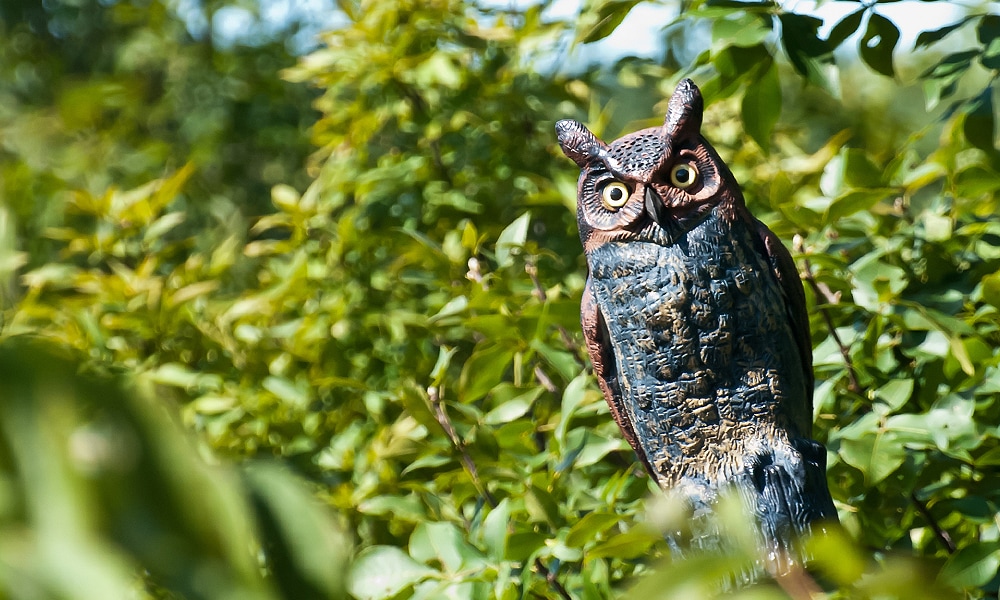
Unfortunately, it’s difficult to hire a predator of hawks to patrol your property. And even if you did, you’ll have the same problem trying to keep small animals safe. So the best way to get rid of hawks by scaring them off is to use a fake hawk predator.
Hawk decoy predators make great deterrents if you pick the right one and use it properly. Life-size, realistic-looking owl decoys that make erratic movement are very effective at scaring away hawks.
But will a fake owl keep hawks away for a long time? The answer is yes, but only if you make an effort to move it around every few days. You can’t just leave it in one place forever and expect it to repel hawks. These birds are smart and will know the owl’s fake if it just stays put.
2. Shield your bird feeders
If you want to wake up to bird song in the morning, chances are you’ve installed a bird feeder or two on your property.
Unfortunately, you may be inadvertently leading those beautiful songbirds to their deaths.
Once hawks know that local birds have a popular hangout spot, you can be sure they’ll be waiting on the wings to swoop in for the kill. This brings a whole new meaning to “bird feeder,” doesn’t it?
The most obvious solution would be to remove the feeder, but no want wants that. If you want to keep hawks away from bird feeders, all you have to do is cover them.

Remember that hawks look for their prey from above. They dive down and take the defenseless animal or bird. If they can’t see what they’re looking for, you can keep those little birds safe.
You can do this by moving your bird feeder under a roof awning, an umbrella, a gazebo, or low-hanging tree branches.
Another way to keep songbirds safe is to get a caged bird feeder. The bars will keep hawks away from them as they eat. If you also want to keep your bird feed away from bullies like grackles or pigeons, this does the job too!
3. Scare hawks with noise deterrents
If you’re desperate to figure out how to scare away hawks from your property, ask yourself: what are hawks afraid of?
And you’ll find that certain sounds at certain frequencies can work wonders at detracting these birds. For noise to be effective, it will need to be erratic, loud, and irritating to birds but not to humans and pets.
The most convenient way to do this is to get an ultrasonic bird repeller. This one is a good choice because it has a lot of customizable settings for volume, frequency, and sensitivity. If you find that the sound is too incessant or too irritating for your home, you can adjust accordingly.
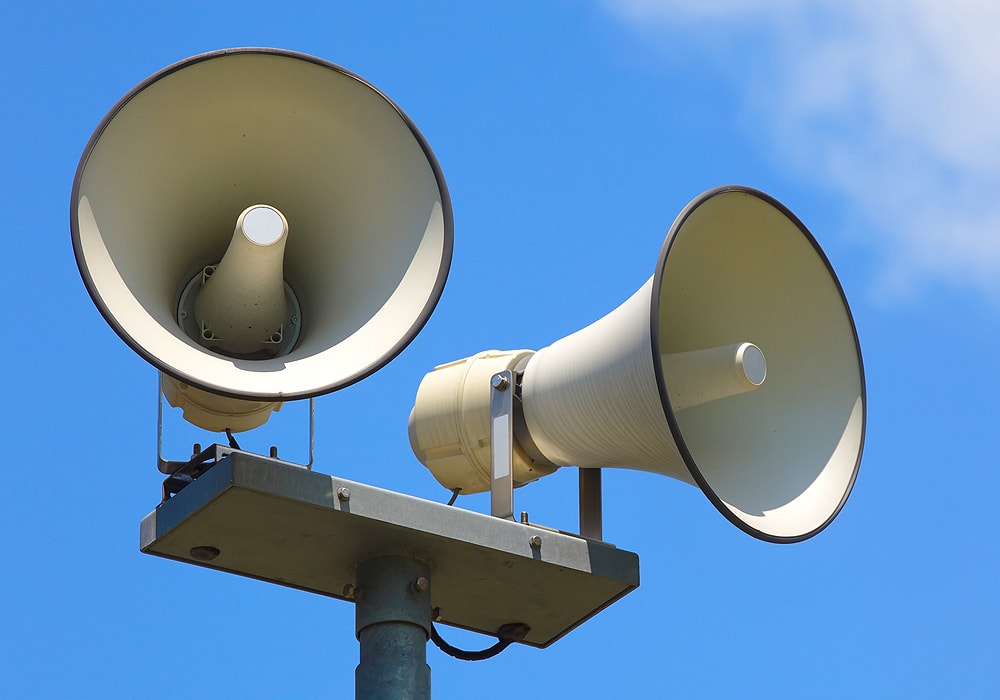
It also comes with strobe lights that act as an additional deterrent at night.
Setting up an anti-hawk noise deterrent device is as easy as plugging it in and positioning it somewhere you don’t want these birds to be.
Place it near poultry and rabbit cages to deter owls and hawks from coming near. Or you can hang it on your backyard wall to discourage them from swooping in.
Using sound is among the best hawk repellents for those who are conscious of environmental impact. With no toxic residues, no adverse environmental effects, and no chance at all of injuring hawks, it’s easy to see why these ultrasonic bird repellent devices are so popular.
4. Install roosting spikes on perching areas
Removing all potential perching areas might leave your property looking barren and shadeless.
But eliminating these predator stalking points is among the best hawk deterrent methods out there. So what can you do?
Instead of removing that roosting area, find a way to make it difficult for hawks to hold on to. This way, you are able to stop the perching behavior without getting rid of the perching surface.
The most convenient way to do this is to install roosting spikes anywhere you think these birds could be waiting. The rods that jut out make it a precarious perching spot for hawks.
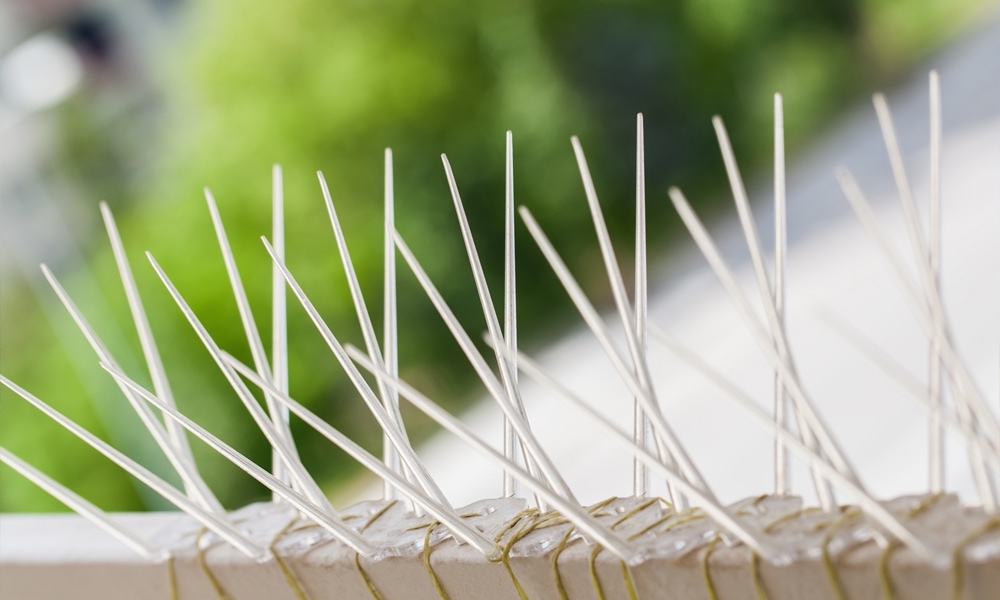
They stalk their prey for quite a while, so comfort and stability is something they look for in vantage spots. With roosting spikes, you make that ledge unviable and get rid of hawks.
Spikes usually come in segments, making it easy to install according to the length of the ledge. You can install segments one after the other or leave a space in between to cover more area.
It’s best to install these on surfaces that stand alone. There are instances when these spikes are positioned on ledges right up against the wall.
The combination of the spikes and the wall serve as good support for nests. So if you don’t want any birds nesting on these, install it correctly.
5. Cover your livestock with net
If you’re a backyard farmer raising a couple of chickens or quails, you must be desperate to find out how to keep hawks away from your flock.
The fear that another victim might be taken may make you scared of leaving them unsupervised out in the open.
So how do you keep hawks away from chickens? The simple answer is to put anti-hawk netting in between them in the form of a chicken pen.
A chicken pen is basically like a large cage where chickens can have valuable outdoor time. It has the dual job of keeping the flock inside while keeping potential predators out.
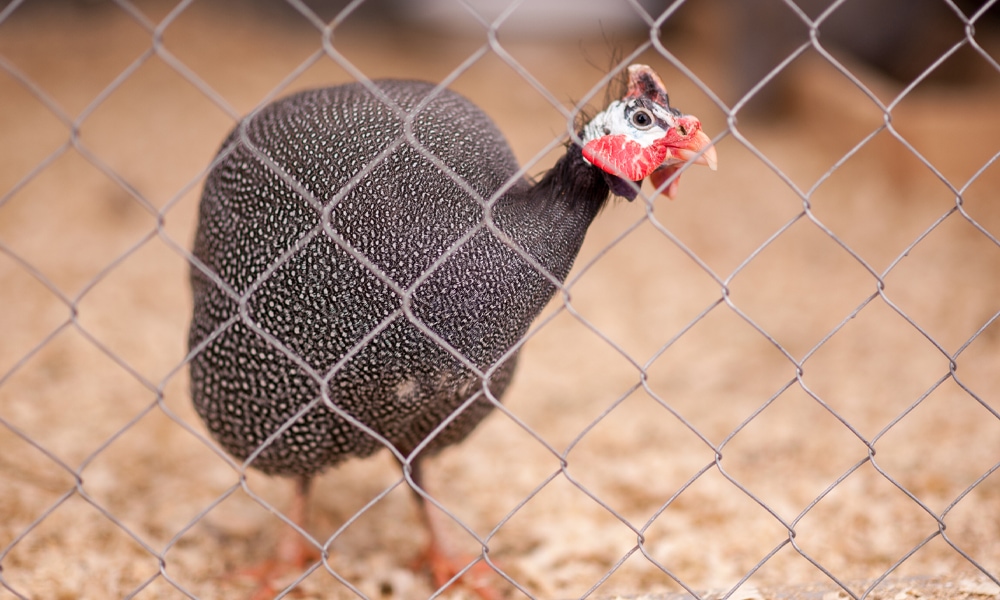
While the walls protect chickens from dogs and cats, the chicken pen’s most important chicken hawk deterrent feature is the ceiling.
Constructing your own chicken pen using wire mesh and wood takes effort and know-how, but it’s a good choice if you want to customize it to fit your needs and your space. The important thing is to make sure the mesh you use is strong and durable.
If building your own chicken pen is beyond you, you could buy a ready-made chicken pen. The one-time setup is easy with the set of instructions that comes with it. Make sure to buy one made of high-quality metal.
6. Remove hawk vantage points
Your quest to find out how to deter hawks starts with knowing their behavior.
These birds like to stake out their prey from a vantage point, waiting until the moment when they’re out in the open and ready for the taking.
Having a convenient place to perch on is essential to these predators. Hence, a simple way to get rid of hawks in backyard is to remove these vantage points.
Hawks like a clear view when they stalk their prey, so watch out for tall trees standing alone, dead branches with no leaf cover, and utility posts.
If you already have hawks screeching above, try to look for where they perch.

Cut down leafless branches or trees standing alone. Detract these birds from perching on utility posts by capping them with anti-bird spikes or metal cones.
Ideally, all potential vantage points within a 100-yard radius from your home should be eliminated. Hawks may have sharp eyes; even they will find it hard stalking prey in a yard 100-yards away.
Without a convenient perch nearby, hawks will seek greener pastures that provide an uninterrupted and close-up view of their food.
7. Remove food sources
The best way to keep hawks away is to remove the reason they’re hanging around your house. And the only thing that will make these birds come back, again and again, is if your home serves an eat-all-you-can hawk buffet.
So what do hawks eat? These are relatively small predators, so hawks eat animals smaller or only slightly bigger than they are.
In the typical residential backyard, hawks usually eat small poultry like chickens or quail and small rodents like rats, voles, and squirrels. Rabbits, small frogs, and small snakes are also fair game. These birds have even been known to carry off puppies and kittens!

If your backyard has any food sources that aren’t supposed to be there anyway, find ways to get rid of them.
Deter rodents and squirrels by securing the garbage, preventing access to crops and fruit, and applying deterrents—control populations of large insects that you may have in your home with environmental-friendly repellents.
Just make sure that whatever you use to get rid of a hawk’s food sources will not harm the hawk itself. So using poisons and glue traps are a no-no.
Remember that these birds are protected by federal law, so check with your wildlife control what you can use to get rid of hawk food safely.
8. Get a rooster
Hawks are major issues for poultry farmers. If you have a hawk killing chickens right on your doorstep, we feel for you. But don’t worry, there is a way to stop it.
If you want something to stand in between hawks and chickens, a rooster is your answer. These large birds have the size and built-in weapons to take on hawks.
Their sharp talons and beaks combined with their fierce need to protect hens make them a great hawk deterrent for chickens.
Buying a rooster for your chickens is like getting a bodyguard for your sheep.
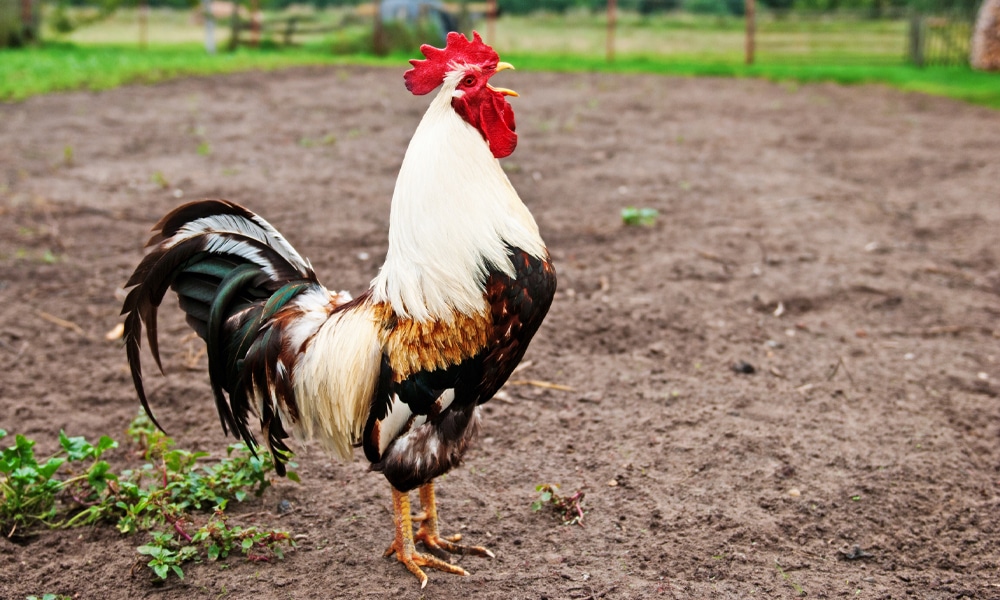
But before you get one, make sure to check your local laws. Some areas require paperwork for you to bring a rooster home.
This is to regulate cockfighting, a blood sport that understandably raises the ire of animal rights groups.
If you’re able to get one, place it near the coup to deter hawks from chickens. Allow it to roam around as hens peck on the ground.
Make sure to enforce measures to keep your rooster from getting aggressive towards the hens. You want him to focus his energy on protecting chickens from hawks.
9. Get a guard dog
If you want to get rid of a hawk killing chickens, consider getting a guard dog. Just the sight of a dog patrolling your property is enough to deter hawks from even trying.
But before anything else, remember that getting a dog–especially one large enough to scare off hawks–is a big responsibility.
The only time you should consider getting a dog to protect your flock is if you are ready to fully commit to pet ownership: from food to training to vet bills and everything in between.
Suppose you’re ready to take on this responsibility, congratulations! You’re in for a hawk-free future. Ideally, your dog should get along well with chickens and be big enough not to be carried off by a hawk.

It may be a good idea to choose a breed with a history of protecting other animals, as they are more likely to have the right temperament and instincts for the job.
But remember that loud noises and movement from a large animal are enough to scare a hawk away. So if you have a dog that likes to bark and enjoys running around the yard, you’ve already got it covered.
If you’re wondering how to scare hawks away with a dog, all you have to do is let him/her out at different times of the day and when you let the chickens out. The unpredictable schedule and the flock’s association with a dog will deter hawks from dropping in.
10. Create a scarecrow
Scarecrows have been used to protect crops since ancient times. It seems that our ancestors had trouble with pesky birds too. But what worked for them then can still work for us today.
Scarecrow may be its popular name, but scare-bird is more appropriate. All birds, regardless of seed-eating, insect-eating, or animal-eating, do not typically like the company of humans.
So even if your idea of a scarecrow lies in a field, having a humanoid figure standing guard in your yard achieves the same effect.

So how do you make your own hawk scarecrow? You’ll need two narrow planks of wood to create a lower-case letter “t.” Slip-on an old shirt or a button-down.
For the bottoms, get an old pair of jeans and cut a hole through the crotch so the vertical plank can come through. Leave the legs dangling for extra movement when the wind blows. Then bulk up your “scarehawk” with straw or hay.
Remember, if you want to scare hawks away from your yard, you’ll have to make it as realistic as possible.
The scarecrow should be human-sized and create lots of erratic, unpredictable movements. If you can manage to make it spin, even better! Move it around every 2-3 days, so the hawks think that the scary strawman is moving around.
11. Scare hawks with reflection
Among the safest and cheapest hawk deterrent methods involves the use of reflective surfaces. These objects catch the light, producing unexpected bright flashes that scare hawks away.
You can make your own DIY yard reflectors using household items like aluminum foil, old CDs, reflective tape, or small mirrors. Just use a string to hang them across your open yard.
If you want a convenient option, you can also buy ready-made yard reflectors. These are easier to install, designed to be durable for outdoor use, and made to catch as much light as possible.
These reflective rods are spirally-shaped to give more facets from which to reflect light and also to help create an unnatural swirling movement.
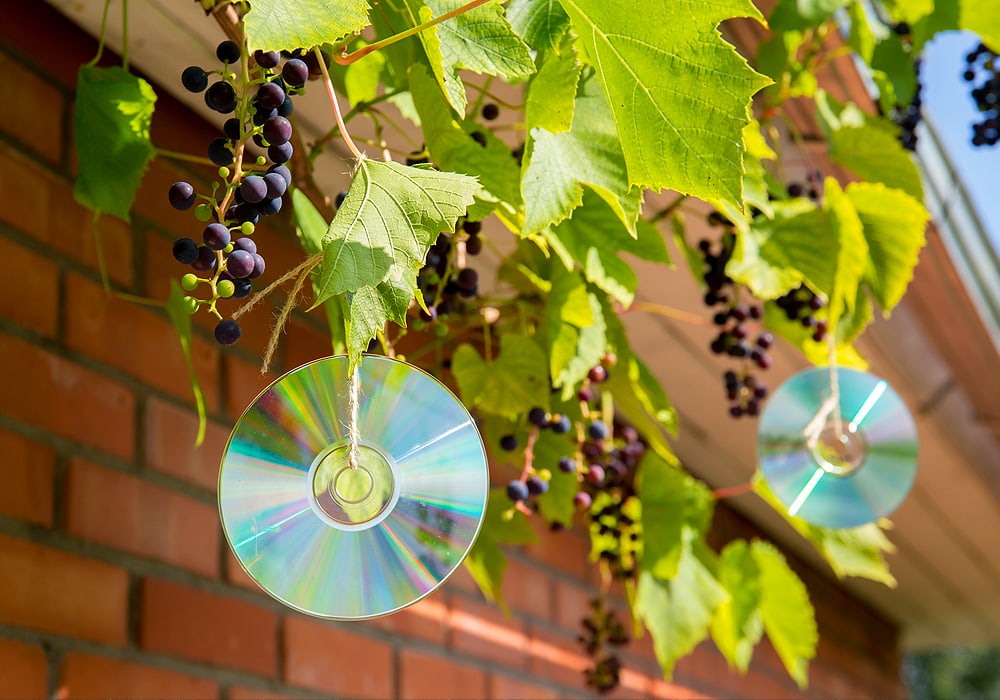
The combination of strange movement and bright flashes is great at scaring hawks away.
You can also try these groovy holographic owls. There are three hawk repellent features: the rainbow hologram that reflects lights blindingly, the yellow predator-like eyes designed to make the animal think their movements are being followed, and bells that emit sudden sounds when moved by the wind.
Simply hang these across your yard or near structures of the animals you’re trying to protect, and the hawks will be wary of your property.
Stringing these across your yard will create a great hawk deterrent for small dogs that are usually inside the house but are allowed to go out to potty.
12. Avoid ground feeding
It’s a nice feeling to scatter bird feed on the ground and watch birds flock to your yard, picking at the seeds and grains. Unfortunately, ground feeding birds is also a good way of ground feeding hawks.
While these little birds are focused on pecking at the ground, they become unaware of any danger lurking nearby.
They’re sitting ducks on wide open ground, making easy pickings for hawks. When they do realize the danger is near, it’s already too late.
The hawk is extremely fast and quiet when it decides to swoop in for the kill. It was built to do that, after all.
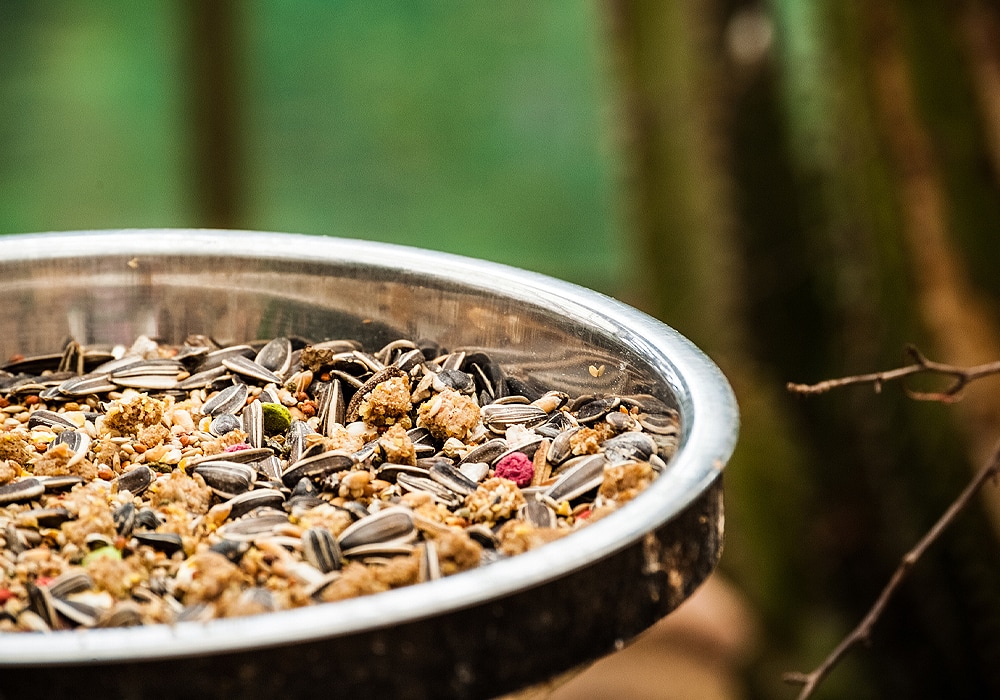
One way to minimize the hawk’s predatory success is to avoid grounding feeding altogether. If these birds are not fed in low feeders or on the ground, the hawk’s accuracy isn’t nearly as good.
If you still want birds visiting your home, there are other ways of feeding that make them less vulnerable to hawk attacks.
This, combined with other anti-hawk measures, can help keep the songbirds safe without harming the hawks.
13. Offer refuge for songbirds
If you want to feed birds without inviting hawks over for a buffet, it can be done by strategic positioning and landscaping.
By giving cover and places to hide, you can tip the scales in favor of the prey rather than the predator. Place your birdfeeder under the shade of trees–the denser, the better.
Hawks need to see their prey from above for them to dive down, but if their view is obstructed by branches and leaves, they’ll most likely miss.
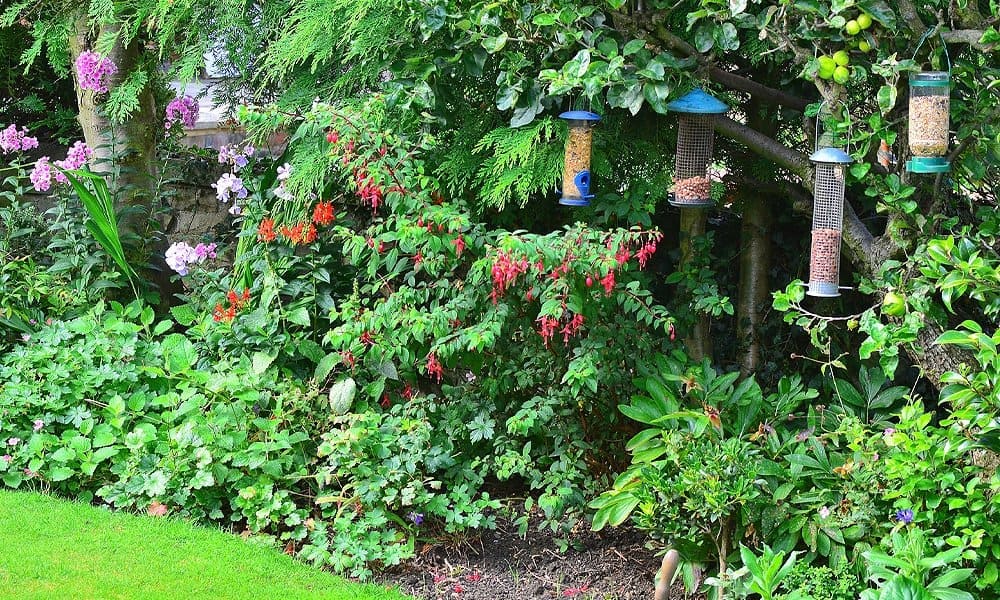
Provide low shrubbery, bushy and leafy plants, and thick brush within 8 feet of your birdfeeder. This way, even if a hawk attempts to take a small bird, the would-be prey has a lot of nearby hiding places to fly to.
Keep this in mind when you are landscaping your home. Choose trees and plants native to your location because these are also what the local birds are used to.
You can plant fruits, flowers, and seed-bearing plants to attract more birds. These natural bird feeders not only replenish themselves every season but provide leaf cover to keep birds safe from birds of prey.
14. Get rid of bird feeders
Bird feeders are magnets not just for birds but for small animals too. Chipmunks, squirrels, and rats all enjoy their visits to bird feeders.
These little pests gorge themselves on the food, leaving you wondering why you don’t hear tweets even if all your bird feed is gone at the end of the day.
But attracting small animals and birds will definitely attract hawks. Once they realize your property has a feeding hole for their prey, you can be sure they’ll sit and wait.
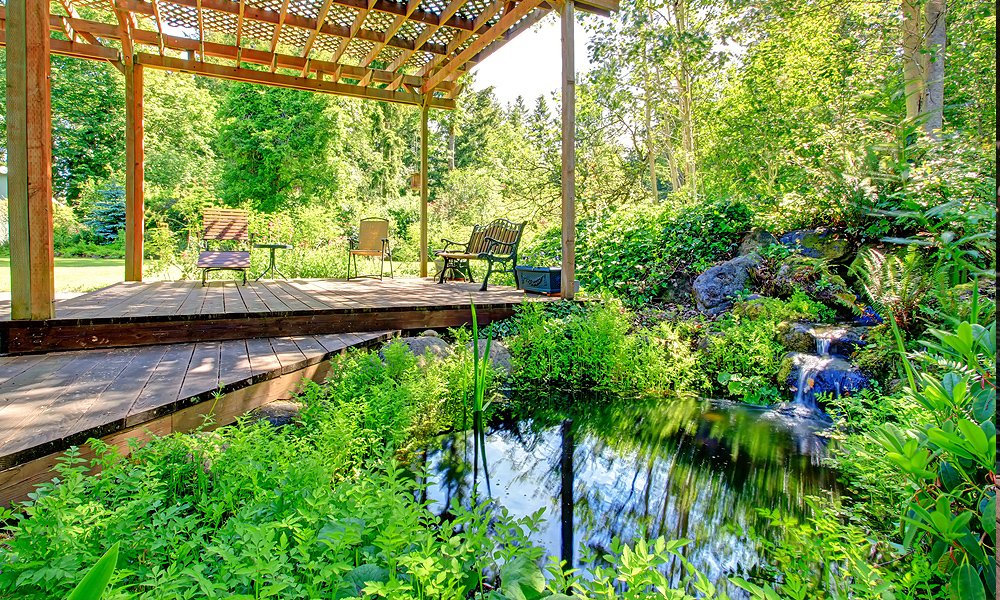
They may take a hummingbird on breakfast on Monday, then have a rat for Wednesday lunch.
Bird feeders provide a wide variety of food to hawks, so they’re bound to enjoy hanging out at your place.
And if you have chickens, rabbits, or small dogs around, these birds of prey might turn their attention on them instead.
The safest thing to do is get rid of your bird feeder completely. It cuts off the supply chain for hawk food at its root.
With no birds, squirrels, chipmunks, or rodents to feed on, the hawk will fly towards greener pastures.
15. Call a professional
If you’ve tried all the tricks in the book to scare away hawks and yet that hawk hanging around your backyard still won’t leave you and your animals alone, you might want to call in wildlife control services.
These guys know how to get rid of hawks that have marked your home as their own. Make sure to call in a legitimate wildlife control company that abides by state regulations.
These birds may be giving you hell right now, but you won’t want to eradicate them from the local ecosystem. They help keep rodents and pest populations from rising and contribute to biological diversity.

It is for these reasons that hawks are protected by law. Depending on the state, there may be fines or even jail time if these birds are treated poorly.
Hiring a professional wildlife control company may be more expensive than doing it yourself, but the expertise and equipment they have to go a long way in making sure that your property stays hawkless.
With their help, you will be able to keep your animals safe without harming these valuable members of the ecosystem.
Related:


I have trouble with a hawk that visits my yard and back yard. I have a 15 year old Jack Russell. He goes out with me on a leash. I use a metal boiler and a heavy large spoon like a drum. The hawk sits a looks but finally leaves because of loud noises. Also I hollow at him telling him to go. He does go away To 4 other yards. Thank you for your comments and tips.
My Houston suburb is invested with hawks! It feels like they’re ALWAYS above us circling the houses, diving into the trees and then dropping down to the ground to eat the bird they caught. If you try to shoo them off they become extremely aggressive. The minute I let my little dog out in my back yard, they’re circling close. Once one swooped down at her. I charged at it, so it swerved to the fence and just watched as I grabbed my puppy and ran inside. I feel harassed by these predators.
would the wildlife department do anything about hawks in my area? They live in the large trees across the street in a rural area. They land on the roof of my home and when I go outside they circle me until I go inside.
I want to scare the hawk away but seems some of the ways also will scare the birds away. I do put sunflower seeds out and seeds but the squirrels eat most of it, its really annoying! But I’ve seen the hawks around alot I’ve even gone out and clapped my hands to make it fly away but I can’t be out doing that everyday lol. Oh well lol.
squirrels don’t like hot pepper powder and birds don’t taste it so there’s lots of seed mix with hot pepper or you can mix in your own. don’t wipe your eyes after is my best tip 😀
I love to feed the birds and I do get many as apart from a couple of other neighbours they have chopped down all of their trees which i think is terrible. I have managed to save a few birds as starlings start to scream but I am elderly and one of these days will fall when i rush out clapping and screaming. I did read on another forum that a guy has been quite successful blowing a loud whistle. I might try that. Others suggest a gunshot but that is only available on youtube and i would not have time to get onto the website and make the shot sound. I bought a hawk deterrent, a big yellow balloon thing with scary eyes but they just get used to that.
I have three hawks hunting together. They killed my rooster!
I find a Paint Ball gun scares the hell out of them!
I had 4 chickens killed by a hawk and 1 by a stinky raccoon rip